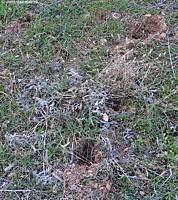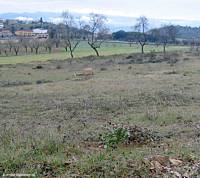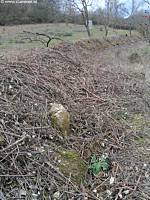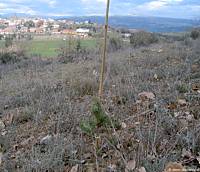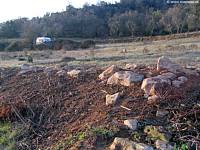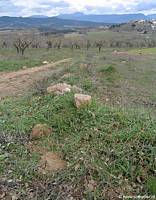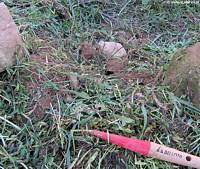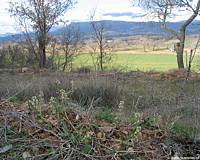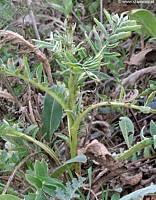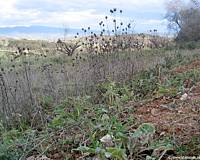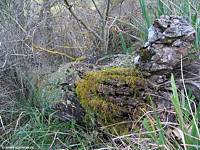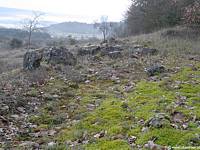|
|
Nature
Switched On
|
|
|
introduction |
2007 February 17 & 18, Saturday & Sunday We have had some visitors who were quite
enthusiastic about our terrain. Not being exactly refined they
showed their enthusiasm in a rude, as not
Of the other bigger mammals I expected to see one
day a rabbit or hare. Parts of the grasslands have a somewhat grazed
appearance for being so short and I wouldn't be surprised to find
some grazing rabbits although I haven't found any fresh droppings.
Our neighbour insisted that most of the rabbits disappeared after
the outbreak of myxomatosis years ago. Nevertheless I saw one
on Sunday evening on our way back home, 2 km from the terrain.
On the left here a
Viburnum tinus
(Lauristine).
It flowers in winter, has a tropical appearance with its thick
laurel-like leaves and is very popular as a garden shrub but
really native in Spain and the Pyrenees. It is a relict species from the Tertiary
Period when the climate was tropical.
Not completely native is this Common Sage (Salvia officinalis),
depending of what you call species or subspecies (lavandulifolia).
It's a popular kitchen and medicinal herb which is widely cultivated and appears wooded
in many places all over the Mediterranean. I planted it on the site of the former hedgerow of
brambles. At the background of the same photograph you can see a
dwarf specimen of an almond tree. It had been almost suffocated by
the brambles but there seems to be still some life in its wood. |
|
|
Looking east, at the entrance to the terrain.
|
||
|
Looking north west along the
former line of brambles. Sunday 14:05 |
||
|
|
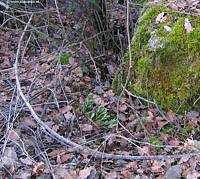
Not bought but taken from nature were these layers of Arctostaphylos uva-ursi. It grows abundantly in nearby woods but not on the terrain. It is melliferous, has antiseptic qualities and offers elegant ground cover.
In many parts of the terrain there are no clear footpaths yet and in order to protect some very young shrubs and trees from being trampled I put two dozens of sticks next to plants like Juniperus oxycedrus, Crateagus monogyna, Quercus faginea and Pinus sylvestris.
|
|
|
Looking east.
Juniperus oxycedrus. |
||
|
Of last week's job there
still had to be carried and placed some stones at the extreme north
With the same philosophy in mind I
|
||
|
Looking south in the extreme north corner. |
||
|
The place of the new hedge. Looking north-east along the path to the entrance. Sunday 14:02 |
||
|
Looking north-east in the central area.
|
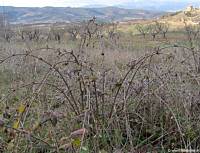 Here
it is on the left. The elegant curves seem to serve the special
purpose of pushing the extremes almost literally into the soil. The
only thing I had to do was cut them for a length of 40 cm and
pulling them with little effort out of the soil. Here
it is on the left. The elegant curves seem to serve the special
purpose of pushing the extremes almost literally into the soil. The
only thing I had to do was cut them for a length of 40 cm and
pulling them with little effort out of the soil. These so called 'layers' showed an interesting re-orientation of the direction of bud growth. It's a miracle how the sap stream inside these plants 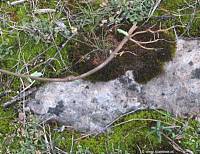 can
cope with these confusing changes of what is up and what is down. can
cope with these confusing changes of what is up and what is down.
|
|
|
A Honeysuckle layer. The bud of leaves is clearly adopting a new
orientation. 18:02 |
||
|
The red point indicates a
planted Honeysuckle layer. A planted Hawthorn is in the centre of
the three pebbles. It is clear that I will have to control the grass
growth for the first couple of months. 18:25 |
||
|
Looking north from the lower centre. |
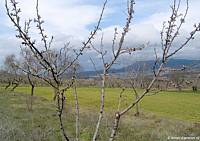
The almond trees were at the point of flowering with some branches already doing so.
Another early flower was this Reseda phyteuma on the left, an annual mignonette, unfortunately not so fragrant as other genus members.
In the eastern part was a group of Greater Knapweed (Centaurea scabiosa) which also had clearly made an attempt to flower but had failed: the buttons had been frozen or simply withered. Another sign of climatic change?
|
|
| Looking
north from the centre. Sunday 17:11 |
||
| Looking
east in the eastern part. Centaurea scabiosa with frozen or withered flowers. Sunday 17:08 |
||
|
In the lower central part. Thymus vulgaris, Jasminum fruticans, Sedum sediforme, Brachypodium retusum. Sunday 17:55 |
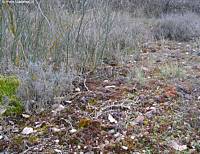
It is clear, we are waiting for the spring, a season we have never experienced on the terrain. But this doesn't mean that winter has little to offer, quite the contrary is true especially when it comes to subtleties of colour and textures. Perhaps the following images give some testimony.
|
|
|
Looking east, in the higher central part. |
Half decomposed trunk of an almond tree in the eastern part. Sunday 17:46 |
|
|
introduction
|
|
|
